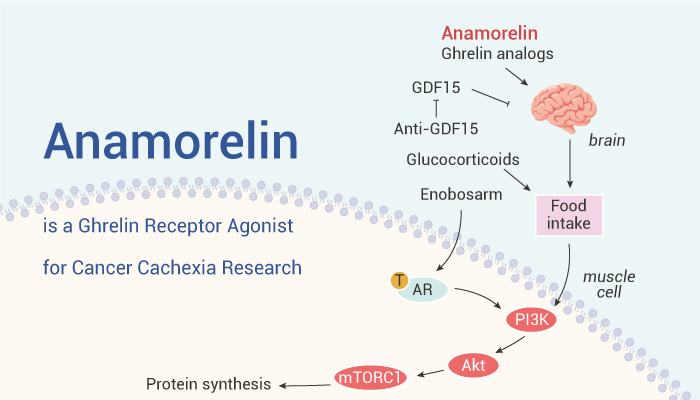GHSR (Growth hormone secretagogue receptor; ghrelin receptor) is a seven transmembrane G protein-coupled receptor with high expression in the anterior pituitary, pancreatic islets, thyroid gland, heart and various regions of the brain. Two types of GHSR are accepted to be present, GHS-R1a and GHS-R1b. GHSR is a G protein-coupled receptor that binds growth hormone secretagogues (GHSs). The role of GHS-R is thought to be in regulating energy homeostasis and body weight. In the brain, they are most highly expressed in the hypothalamus, specifically the ventromedial nucleus and arcuate nucleus. The effects of ghrelin on signaling nutrient availability to the central nervous system, upregulating food intake, lowering energy expenditure, and stimulating GH release are relevant in the management of diseases such as cancer anorexia-cachexia syndrome (CACS).
Anamorelin is an orally active ghrelin receptor agonist with an EC50 value of 0.74 nM in the FLIPR assay.
Meanwhile, Anamorelin (RC-1291 or ONO-7643) shows weak binding to the calcium channel L-type receptors, the serotonin transporter, and the sodium channel. Therefore, the compound exhibits a high selectivity versus ghrelin receptors. Moreover, Anamorelin hasg a longer half-life (approximately 7 h) than ghrelin. In addition, Anamorelin stimulates neuroendocrine responses and can induce rapid positive effects on appetite and metabolism. In rats, Anamorelin (3-30 mg/kg) significantly and dose-dependently increases food intake and body weight. Furthermore, Anamorelin significantly increases growth hormone (GH) levels at 10 or 30 mg/kg doses. Thus, Anamorelin has the potential for cancer anorexia-cachexia syndrome (CACS) and non-small cell lung cancer (NSCLC) research.
To sum up, Anamorelin is a selective and orally active ghrelin receptor agonist, has the potential for CACS and NSCLC research.
References:
[1] Pietra C, et al. J Cachexia Sarcopenia Muscle. 2014 Dec;5(4):329-37.
